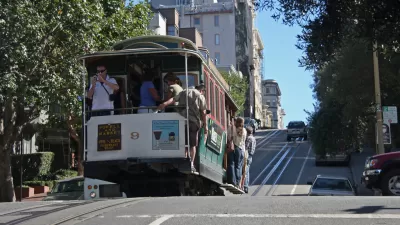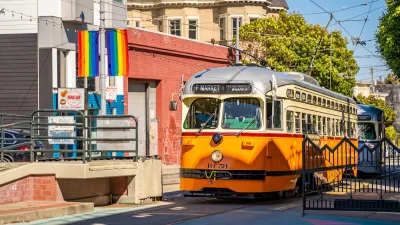They're a global icon of the City by the Bay and one of San Francisco's premier tourist attractions. Operating at a loss, the city's cable cars are also draining resources from more essential forms of public transit, writes Joe Eskenazi.

"Cable cars are often blithely referred to as the sole transit system on the National Register of Historic Places. Grand — but, conversely, this means it's the only Historic Place in which funding for upkeep, personnel, and, perhaps, the odd severed foot competes with the dollars keeping core transit operations running," notes Eskenazi. "Maintaining cable cars for city tourists while struggling to provide core transit service is a bit like polishing the heirloom china for the guests while sending the kids to school with no shoes."
"All told, the cable cars required $55.6 million in expenses, meaning Muni took a hit of nearly $31 million operating them in '11," he explains. "When it comes to Muni math, these are pretty decent numbers — cable cars' 'fare recovery' of 44.8 percent of operating expenses from passengers dwarfed the system's overall tally of just 30 percent in 2011."
"But you can justify running buses and light-rail vehicles at a loss because they're vital transportation. You can't make the same justifications for a boutique rail service where, for the vast majority of its 19,000-odd daily passengers, a ride serves as an end in and of itself."
FULL STORY: Running of the Bull: Cable Cars Are Trundling Money Away From the Transit You Actually Use

Alabama: Trump Terminates Settlements for Black Communities Harmed By Raw Sewage
Trump deemed the landmark civil rights agreement “illegal DEI and environmental justice policy.”

Study: Maui’s Plan to Convert Vacation Rentals to Long-Term Housing Could Cause Nearly $1 Billion Economic Loss
The plan would reduce visitor accommodation by 25% resulting in 1,900 jobs lost.

Planetizen Federal Action Tracker
A weekly monitor of how Trump’s orders and actions are impacting planners and planning in America.

Waymo Gets Permission to Map SF’s Market Street
If allowed to operate on the traffic-restricted street, Waymo’s autonomous taxis would have a leg up over ride-hailing competitors — and counter the city’s efforts to grow bike and pedestrian on the thoroughfare.

Parklet Symposium Highlights the Success of Shared Spaces
Parklets got a boost during the Covid-19 pandemic, when the concept was translated to outdoor dining programs that offered restaurants a lifeline during the shutdown.

Federal Homelessness Agency Places Entire Staff on Leave
The U.S. Interagency Council on Homelessness is the only federal agency dedicated to preventing and ending homelessness.
Urban Design for Planners 1: Software Tools
This six-course series explores essential urban design concepts using open source software and equips planners with the tools they need to participate fully in the urban design process.
Planning for Universal Design
Learn the tools for implementing Universal Design in planning regulations.
Caltrans
Smith Gee Studio
Institute for Housing and Urban Development Studies (IHS)
City of Grandview
Harvard GSD Executive Education
Toledo-Lucas County Plan Commissions
Salt Lake City
NYU Wagner Graduate School of Public Service





























